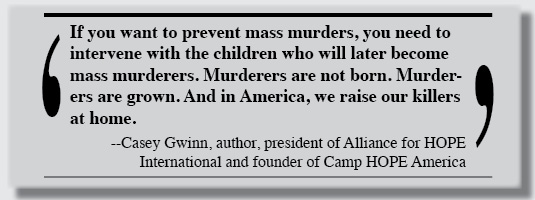— Part 7 of an 8-Part Series —
In the U.S., school shootings have grown in frequency in the last five years, forcing Americans to search for the internal cause of these horrific acts of violence. We blame everything from TV shows to video games to movies, but is that valid? Are these credible concerns?
Because of the rapid development of technology, kids today may be facing unconventional issues that older generations never knew as children. We are so reliant on technology that adult supervision has been replaced with technology such as TV, mobile devices and game consoles, as they consume a significant portion of our time each day. According to the American Pediatric Association, the estimated time that children in the U.S. spend on media devices is an average of seven hours a day. Thus, families are less connected, lacking trust and love, which can result in the absence of appropriate supervision and parental guidance. In those seven hours a day or so, media has control as to what children may perceive to be true. “An average American child,” Michigan Medicine said, “will see 200,000 violent acts and 16,000 murders on TV by age 18.” Violence in the media is a common occurrence, from TV ads of war games to the latest horror movies, desensitizing children to these vivid outlets. Parents worry that if their children play and watch these violent games, they’ll soon become brainwashed to believe violent behavior is acceptable. According to Common Sense Media, “a whopping 75 percent of polled parents say they think violent video games contribute to violence.” Experts say violent behavior usually attracts violence stimulants, such as the need to play aggressive video games and watch violent TV shows. “Aggressive behaviors among children are becoming an increasingly important and challenging topic in mental health care,” NCBI wrote. “These behaviors tend to start in early childhood and have been observed in up to 72 percent of children from ages 12-16.” The number of mass shootings has skyrocketed over the past five years, which has contributed to a controversial argument of what elements make up the reasons for these obscene behaviors. According to Daily Signal, “more than 1,600 mass shootings have occurred in the U.S. since the massacre at Sandy Hook Elementary School more than five years ago, in December 2012.” Is violent media the cause? Lenient gun laws? A lack of parental care? “A lot of my children patients would come from a rough, unstable home environment which would cause them to act out in a violent way,” said Shanice Hayes, registered nurse in behavioral health at SSM Health Depaul Hospital in Bridgeton, Missouri. The key components researchers have found relate back to the shooter’s early childhood. Children who have had harsh, rejecting parents, interparental violence, child abuse or fatherless households are more prone to violent behavior as they grow up, and often, the unfortunate truth about divorced households is the dismissal of the father’s relationship with the children. “85 percent of children with behavioral disorders have only a mother in the home,” according to the Centers for Disease Control. Most of America’s mass killers came from broken homes. Stephen Paddock, Dylann Roof, Adam Lanza, Wade Page, John Zawahiri and Scott Evans Dekraai are just a few. Roof’s father divorced his mother, leaving his stepmother to raise him. In 2015, Roof killed nine people at a church in Charleston, South Carolina. Zawahiri’s parents had been separated for years when he killed five people in Santa Monica on the campus of a state college in 2013. Dekraai, also with divorced parents, walked into his ex-wife’s hair salon in 2011 and shot her and seven others dead. Families need to heal after a split. We tend to put Band-Aids over our problems and return to our busy lives, but this leaves emotional damage and resentment which then affects children long-term. Casey Gwinn, president of Alliance for HOPE International, founder of Camp HOPE America and author of, “Cheering for the Children: Creating Pathways to HOPE for Children Exposed to Trauma,” said we need to invest in trauma-exposed children with internalized rage from violence, abuse and abandonment issues. “If you want to prevent mass murders, you need to intervene with the children who will later become mass murderers,” Gwinn said. “Murderers are not born. Murderers are grown. And in America, we raise our killers at home.”
